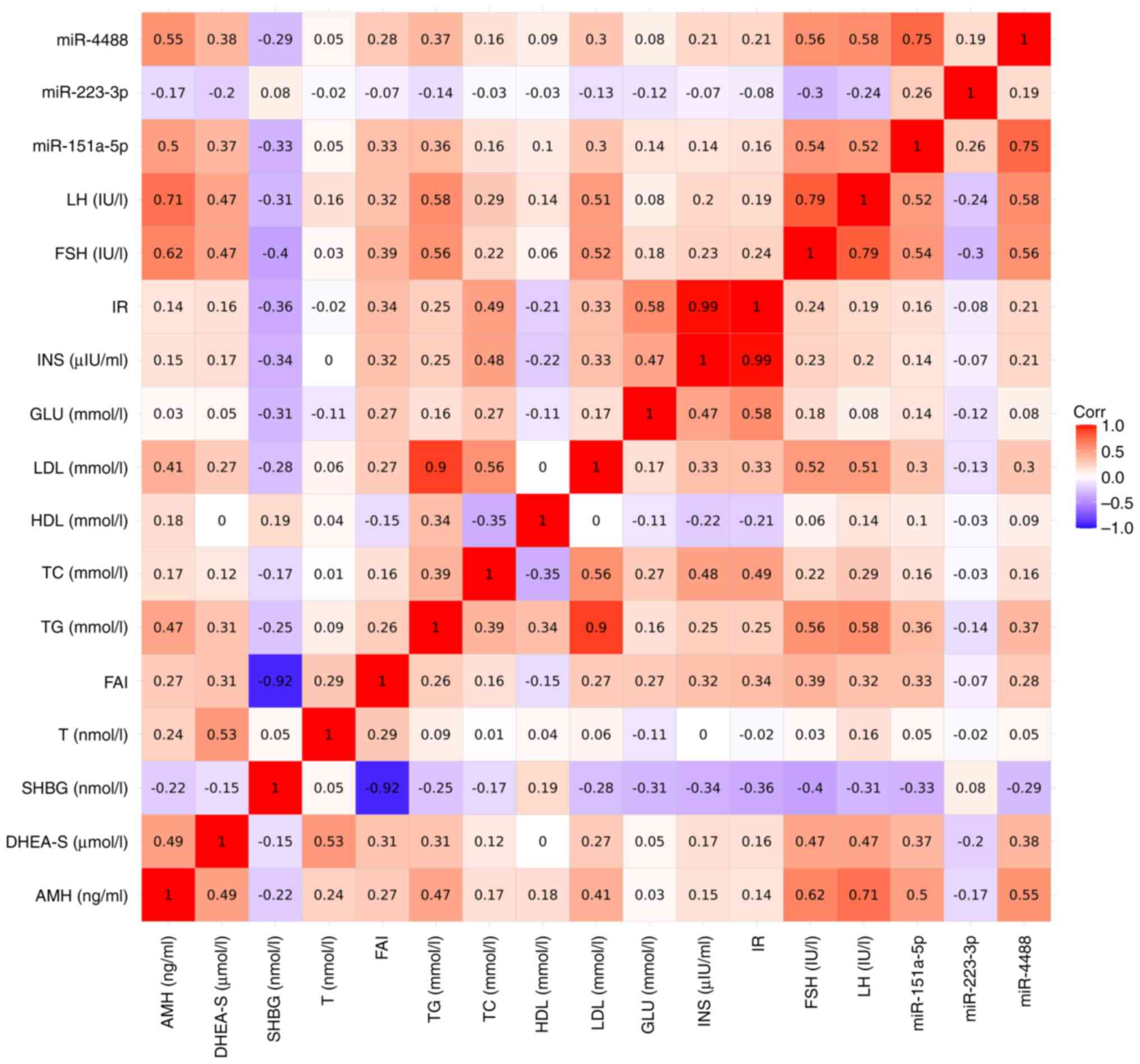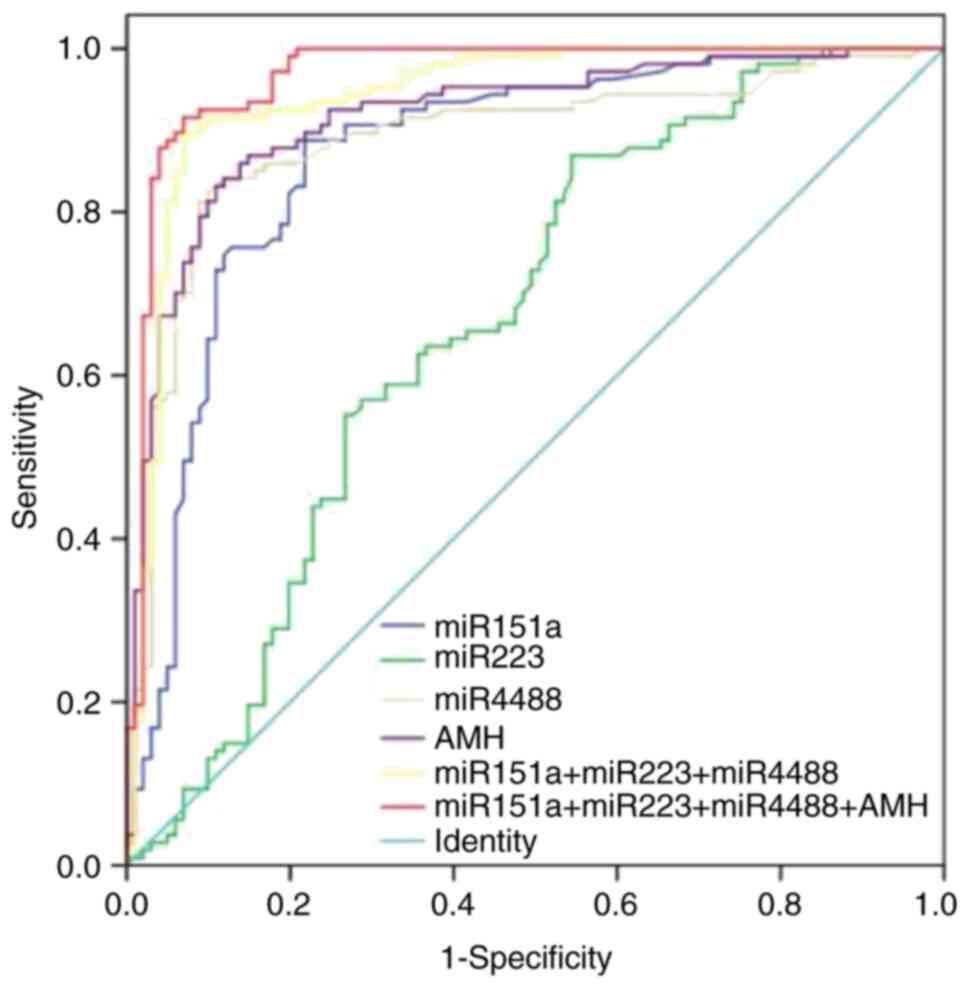|
1
|
Dunaif A: Insulin resistance and the
polycystic ovary syndrome: Mechanism and implications for
pathogenesis. Endocr Rev. 18:774–800. 1997.PubMed/NCBI View Article : Google Scholar
|
|
2
|
Yildiz BO, Bozdag G, Yapici Z, Esinler I
and Yarali H: Prevalence, phenotype and cardiometabolic risk of
polycystic ovary syndrome under different diagnostic criteria. Hum
Reprod. 27:3067–3073. 2012.PubMed/NCBI View Article : Google Scholar
|
|
3
|
Vitek W, Hoeger K and Legro RS: Treatment
strategies for infertile women with polycystic ovary syndrome.
Minerva Ginecol. 68:450–457. 2016.PubMed/NCBI
|
|
4
|
Skog J, Würdinger T, van Rijn S, Meijer
DH, Gainche L, Sena-Esteves M, Curry WT Jr, Carter BS, Krichevsky
AM and Breakefield XO: Glioblastoma microvesicles transport RNA and
protein that promote tumor growth and provide diagnostic
biomarkers. Nat Cell Biol. 10:1470–1476. 2008.PubMed/NCBI View
Article : Google Scholar
|
|
5
|
Ohshima K, Inoue K, Fujiwara A, Hatakeyama
K, Kanto K, Watanabe Y, Muramatsu K, Fukuda Y, Ogura S, Yamaguchi K
and Mochizuki T: Let-7 microRNA family is selectively secreted into
the extracellular environment via exosomes in a metastatic gastric
cancer cell line. PLoS One. 5(e13247)2010.PubMed/NCBI View Article : Google Scholar
|
|
6
|
Sun Z, Shi K, Yang S, Liu J, Zhou Q, Wang
G, Song J, Li Z, Zhang Z and Yuan W: Effect of exosomal miRNA on
cancer biology and clinical applications. Mol Cancer.
17(147)2018.PubMed/NCBI View Article : Google Scholar
|
|
7
|
Hossain MM, Cao M, Wang Q, Kim JY,
Schellander K, Tesfaye D and Tsang BK: Altered expression of miRNAs
in a dihydrotestosterone-induced rat PCOS model. J Ovarian Res.
6(36)2013.PubMed/NCBI View Article : Google Scholar
|
|
8
|
Sirotkin AV, Lauková M, Ovcharenko D,
Brenaut P and Mlyncek M: Identification of microRNAs controlling
human ovarian cell proliferation and apoptosis. J Cell Physiol.
223:49–56. 2010.PubMed/NCBI View Article : Google Scholar
|
|
9
|
Sørensen AE, Wissing ML, Salö S, Englund
AL and Dalgaard LT: MicroRNAs related to polycystic ovary syndrome
(PCOS). Genes (Basel). 5:684–708. 2014.PubMed/NCBI View Article : Google Scholar
|
|
10
|
Ambros V: MicroRNAs: Tiny regulators with
great potential. Cell. 107:823–826. 2001.PubMed/NCBI View Article : Google Scholar
|
|
11
|
Bartel D: MicroRNAs: Genomics, biogenesis,
mechanism, and function. Cell. 116:281–297. 2004.PubMed/NCBI View Article : Google Scholar
|
|
12
|
Gallo A, Tandon M, Alevizos I and Illei
GG: The majority of microRNAs detectable in serum and saliva is
concentrated in exosomes. PLoS One. 7(e30679)2012.PubMed/NCBI View Article : Google Scholar
|
|
13
|
Hunter MP, Ismail N, Zhang X, Aguda BD,
Lee EJ, Yu L, Xiao T, Schafer J, Lee ML, Schmittgen TD, et al:
Detection of microRNA expression in human peripheral blood
microvesicles. PLoS One. 3(e3694)2008.PubMed/NCBI View Article : Google Scholar
|
|
14
|
Diez-Fraile A, Lammens T, Tilleman K,
Witkowski W, Verhasselt B, De Sutter P, Benoit Y, Espeel M and
D'Herde K: Age-associated differential microRNA levels in human
follicular fluid reveal pathways potentially determining fertility
and success of in vitro fertilization. Hum Fertil (Camb). 17:90–98.
2014.PubMed/NCBI View Article : Google Scholar
|
|
15
|
Da Silveira JC, Veeramachaneni DN, Winger
QA, Carnevale EM and Bouma GJ: Cell-secreted vesicles in equine
ovarian follicular fluid contain miRNAs and proteins: A possible
new form of cell communication within the ovarian follicle. Bio
Reprod. 86(71)2012.PubMed/NCBI View Article : Google Scholar
|
|
16
|
Sang Q, Yao Z, Wang H, Feng R, Wang H,
Zhao X, Xing Q, Jin L, He L, Wu L and Wang L: Identification of
microRNAs in human follicular fluid: Characterization of microRNAs
that govern steroidogenesis in vitro and are associated with
polycystic ovary syndrome in vivo. J Clin Endocrinol Metab.
98:3068–3079. 2013.PubMed/NCBI View Article : Google Scholar
|
|
17
|
Simons M and Rapose G: Exosmes-vesicular
carriers for intercellular communication. Curr Opin Cell Biol.
21:575–581. 2009.PubMed/NCBI View Article : Google Scholar
|
|
18
|
Santonocito M, Vento M, Guglielmino MR,
Battaglia R, Wahlgren J, Ragusa M, Barbagallo D, Borzì P, Rizzari
S, Maugeri M, et al: Molecular characterization of exosomes and
their microRNA cargo in human follicular fluid: Bioinformatic
analysis reveals that exosomal microRNAs control pathways involved
in follicular maturation. Fertil Steril. 102:1751–1761.e1.
2014.PubMed/NCBI View Article : Google Scholar
|
|
19
|
World Medical Association. World Medical
Association Declaration of Helsinki: Ethical principles for medical
research involving human subjects. JAMA. 310:2191–2194.
2013.PubMed/NCBI View Article : Google Scholar
|
|
20
|
Xiong W, Lin Y, Xu L, Tamadon A, Zou S,
Tian F, Shao R, Li X and Feng Y: Circulatory microRNA 23a and
microRNA 23b and polycystic ovary syndrome (PCOS): The effects of
body mass index and sex hormones in an Eastern Han Chinese
population. J Ovarian Res. 10(10)2017.PubMed/NCBI View Article : Google Scholar
|
|
21
|
Xiao CC, Liu YF, Wang TF, Xu MB, Du HL,
Han YH, et al: International clinical practice guideline of chinese
medicine climacteric syndrome. World J Tradit Chin Med. 7:276–279.
2021.
|
|
22
|
Gynecologic Endocrinology Subgroup,
Chinese Society of Obstetrics and Gynecology, Chinese Medical
Association. Guideline on diagnosis and treatment of abnormal
uterine bleeding: 2022 revisions. Zhonghua Fu Chan Ke Za Zhi.
57:481–490. 2022.PubMed/NCBI View Article : Google Scholar : (In Chinese).
|
|
23
|
Vermeulen A, Verdonck L and Kaufman JM: A
critical evaluation of simple methods for the estimation of free
testosterone in serum. J Clin Endocrinol Metab. 84:3666–3672.
1999.PubMed/NCBI View Article : Google Scholar
|
|
24
|
Albareda M, Rodríguez-Espinosa J, Murugo
M, de Leiva A and Corcoy R: Assessment of insulin sensitivity and
beta-cell function from measurements in the fasting state and
during an oral glucose tolerance test. Diabetologia. 43:1507–1511.
2000.PubMed/NCBI View Article : Google Scholar
|
|
25
|
Rana S, Yue S, Stadel D and Zöller M:
Toward tailored exosomes: the exosomal tetraspanin web contributes
to target cell selection. Int J Biochem Cell Biol. 44:1574–1584.
2012.PubMed/NCBI View Article : Google Scholar
|
|
26
|
Blanchard N, Lankar D, Faure F, Regnault
A, Dumont C, Raposo G and Hivroz C: TCR activation of human T cells
induces theproduction of exosomes bearing the TCR/CD3/zeta complex.
J Immunol. 168:3235–3241. 2002.PubMed/NCBI View Article : Google Scholar
|
|
27
|
Livak KJ and Schmittgen TD: Analysis of
relative gene expression data using real-time quantitative PCR and
the 2(-Delta Delta C(T)) method. Methods. 25:402–408.
2001.PubMed/NCBI View Article : Google Scholar
|
|
28
|
Long W, Zhao C, Ji C, Ding H, Cui Y, Guo
X, Shen R and Liu J: Characterization of serum microRNAs profile of
PCOS and identification of novel non-invasive biomarkers. Cell
Physiol Biochem. 33:1304–1315. 2014.PubMed/NCBI View Article : Google Scholar
|
|
29
|
Yin M, Wang X, Yao G, Lü M, Liang M, Sun Y
and Sun F: Transactivation of miR-320 by miR-383 regulates
granulosa cell functions by targeting E2F1 and SF-1 proteins. J
Biol Chem. 289:18239–18257. 2014.PubMed/NCBI View Article : Google Scholar
|
|
30
|
Ling HY, Ou HS, Feng SD, Zhang XY, Tuo QH,
Chen LX, Zhu BY, Gao ZP, Tang CK, Yin WD, et al: Change in microRNA
(miR) profile and effects of miR-320 in insulin-resistant 3T3-L1
adipocytes. Clin Exp Pharmacol Physiol. 36:e32–e39. 2009.PubMed/NCBI View Article : Google Scholar
|
|
31
|
Naji M, Aleyasin A, Nekoonam S, Arefian E,
Mahdian R and Amidi F: Differential Expression of miR-93a and
miR-21 in granulosa cells and follicular fluid of polycystic ovary
syndrome associating with diferent phenotypes. Sci Rep.
7(14671)2017.PubMed/NCBI View Article : Google Scholar
|
|
32
|
Li Y, Fang Y, Liu Y and Yang X: MicroRNAs
in ovarian function and disorders. J Ovarian Res.
8(51)2015.PubMed/NCBI View Article : Google Scholar
|
|
33
|
Deswal R and Dang AS: Dissecting the role
of micro-RNAs as a diagnostic marker for polycystic ovary syndrome:
A systematic review and meta-analysis. Fertil Steril.
113:661–669.e2. 2020.PubMed/NCBI View Article : Google Scholar
|
|
34
|
Jiang X, Li J, Zhang B, Hu J, Ma J, Cui L
and Chen ZJ: Differential expression profile of plasma exosomal
microRNAs in women with polycystic ovary syndrome. Fertil Steril.
115:782–792. 2021.PubMed/NCBI View Article : Google Scholar
|
|
35
|
Bost F, Aouadi M, Caron L and Binétruy B:
The role of MAPKs in adipocyte differentiation and obesity.
Biochimie. 87:51–56. 2005.PubMed/NCBI View Article : Google Scholar
|
|
36
|
Wu W, Zhang J, Zhao C, Sun Y, Pang W and
Yang G: CTRP6 regulates porcine adipocyte proliferation and
differentiation by the AdipoR1/MAPK signaling pathway. J Agric Food
Chem. 65:5512–5522. 2017.PubMed/NCBI View Article : Google Scholar
|
|
37
|
Fan HY and Sun QY: Involvement of
mitogen-activated protein kinase cascade during oocyte maturation
and fertilization in mammals. Biol Reprod. 70:535–547.
2004.PubMed/NCBI View Article : Google Scholar
|
|
38
|
Taieb J, Grynberg M, Pierre A, Arouche N,
Massart P, Belville C, Hesters L, Frydman R, Catteau-Jonard S,
Fanchin R, et al: FSH and its second messenger cAMP stimulate the
transcription of human anti-Mullerian hormone in cultured granulosa
cells. Mol Endocrinol. 25:645–655. 2011.PubMed/NCBI View Article : Google Scholar
|
|
39
|
Ajmal N, Khan SZ and Shaikh R: Polycystic
ovary syndrome (PCOS) and genetic predisposition: A review article.
Eur J Obstet Gynecol Reprod Biol X. 3(100060)2019.PubMed/NCBI View Article : Google Scholar
|
|
40
|
Cooney LG, Lee I, Sammel MD and Dokras A:
High prevalence of moderate and severe depressive and anxiety
symptoms in polycystic ovary syndrome: A systematic review and
meta-analysis. Hum Reprod. 32:1075–1091. 2017.PubMed/NCBI View Article : Google Scholar
|
|
41
|
Kolhe JV, Chhipa AS, Butani S, Chavda V
and Patel SS: PCOS and Depression: Common links and potential
targets. Reprod Sci. 29:3106–3123. 2022.PubMed/NCBI View Article : Google Scholar
|



















